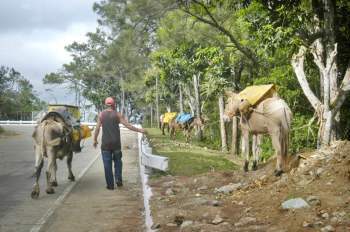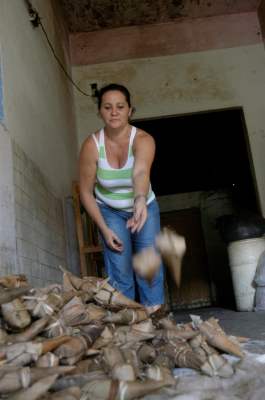Baracoa: The Mecca of Cocoa in Cuba (II*)
By Lazaro Gonzalez, Photos Marta Vecino

HAVANA TIMES, April 18 — Since the 19th century, this region of the eastern extreme of Cuba, Baracoa, has been known as the “Urinal of the Sky” due to its great amount of rainfall – more than 90 inches annually, the most in the country.
The area’s efficient system of natural irrigation and its topographical characteristics (95 percent of the relief is mountainous), ensures that “farming here doesn’t resemble that of anywhere else,” according to agriculture official Alexis Toirac.
Eminently agricultural, Baracoa is a municipality whose production of cocoa, coconut and wood define the execution of national plans for each one of these commodities.
The first two constitute symbols of the region for their marked presence in that environment of dense vegetation and are the traditional bases of campesino culture in the area. Baracoa produces around 75 percent of the country’s total cocoa and 70 percent of the nation’s coconut harvest.
Baracoa: 500 Years of Solitude (Part 1)
It would seem that in this fertile land cocoa and coconut would grow wild. It’s a pleasure to walk through urban courtyards and surrounding-area farms to savor the abundant cocoa plants, proudly exhibiting their fruits almost the entire year.
According to the locals, given the patterns of precipitation and the temperature, Baracoa has an ideal climate for cocoa, once worshipped by the Aztecs who used its seeds as currency in trade. It has two main harvest seasons: a big one from March to June, and another smaller one that extends from September to February.
“Last year this municipality produced only 1,300 tons of cocoa, a figure down from the historical production record of almost 1,500 tons, set at the beginning of last decade,” said delegate Toirac.
 “The price paid by the government to producers today has no relation to the methodical care demanded by this crop. For that reason on many plantations the farmers will intersperse an undergrowth with bananas, which generates better earnings. But this is disastrous for the cocoa because the bananas compete for the nutrients, light and water. We hope to reverse that with the next increase in prices,” Toirac added.
“The price paid by the government to producers today has no relation to the methodical care demanded by this crop. For that reason on many plantations the farmers will intersperse an undergrowth with bananas, which generates better earnings. But this is disastrous for the cocoa because the bananas compete for the nutrients, light and water. We hope to reverse that with the next increase in prices,” Toirac added.
“We’ve gotten to the point of sowing root vegetables on cocoa plantations because we have to survive, and life in the field is hard. I have a family of eight to support, and kids these days don’t want to work the land. Also the price of rice, oil, sugar and salt have gone up; and with what we bring in for cocoa, it’s not enough to make ends meet,” said Osvaldo Hernandez, who despite his moaning recognizes that the benefits from agriculture are enough for him to live in a comfortable and well-furnished masonry home.
Coconuts with cracks
The low prices have also caused a decline in coconut production in this area, which had made their sweet flesh with fruit a recognized emblem at the national level. Deficient agro-technical practices and adverse weather conditions have also impacted on the decline of this crop, which in the 1990s reported annual yields that today seem like a dream: more than 9,000 tons.

“Coconut plantations require operations in sowing, fertilization, fumigation, weeding, cleaning, pruning and others. All of this generates a series of expenses in material and human resources that are not covered by the current price of the fruit. As a result there has been an exodus from coconut plantations, with disastrous consequences for output and the health of those estates,” Toirac noted.
Esteban Quintana, an experienced yet low-income campesino from the area assures that he and other workers sometimes don’t even deliver their coconut to the depository. Instead, they use it for animal feed, “because it’s not worth hauling the product several miles for the pittance we receive.” Like many other producers across the country, Esteban is waiting for new structural reforms to be implemented in the country to see if those improve the purchase price for coconut and cocoa and if bank credit becomes available to campesinos.

Better prices are paid for grains, vegetables and root vegetable, product lines in which Baracoan producers over-fulfill their production plans. The volume of root vegetable harvested here significantly exceeds the demand of the municipality. A similar circumstance exists with vegetables produced in the 26 area greenhouses that are able to satisfy the touristic demand in Baracoa. However, presently these are shipped 90 miles to the provincial capital, Guantanamo, from where — after going through a centralized distribution process — a good part of these vegetables return to Baracoa “as fresh as a globetrotting head of lettuce.”
Forests without doors
Anyone would say that the vegetation in Baracoa creeps and crawls at its own whim, invading everything with its infinity of green shades. This province possesses a wealth of almost 75,000 acres of forests: two thirds wild and the rest as parts of plantations. The Empresa Forestal facility is one of the largest lumber companies in the country and the principal one in the sustainable production of hardwoods – mainly cedar, majagua and najesi.
Luis Manuel Viquillon, the general director of the plant, affirms that last year they met all their forestry goals, which involved work in the area of planting, maintenance and creating a woodland index, among others. “In contrast, we have problems with sawed wood; we were only able to produce 65 percent of the plan because the technological states of our equipment and facilities are substandard. Our equipment is old and gives us some serious headaches.
 Seven months ago, due to problems with the motors, we didn’t have tractors to clear the roads to access the hardwood. The trucks for transporting products function but there are problems with the tires. What’s more, our most modern sawmill broke down and the main bearing will have to be imported.”
Seven months ago, due to problems with the motors, we didn’t have tractors to clear the roads to access the hardwood. The trucks for transporting products function but there are problems with the tires. What’s more, our most modern sawmill broke down and the main bearing will have to be imported.”
In 2010 this company exported 154 tons of hardwood coal, which sells for around 200 dollars a ton. “This item doesn’t generate more profit because we have to sell it as a raw material since we don’t have the technology to process it,” Viquillon pointed out.
Cocoa inside
Like almost all the basic crops involved in Cuban agricultural production, cocoa also has a center for scientific studies, and its headquarters could reside nowhere else other than Baracoa, the mecca of this fruit in Cuba.

The Cocoa Research Station possesses a germplasma bank that conserves at least ten replicas of each of the 256 genotypes of cocoa that exist in the country. “That is a strength of our research and in case of the loss of specimens in the event of damage by natural conditions,” assured Algimiro Nariño, the agency’s director.
This center is devoted basically to the research and creation of high-yield plague-resistant hybrids. Several of those that are patented have been grown in the fields for years with good results. “However we promote the planting of micro-grafted plants or hybrids according to the characteristics of the climate and the soil in each area, and based on our studies of genotype-environment interaction,” said Algimiro.
Yoannis Hernandez, head of the micro-grafting team, pointed out that micro-grafting is viable economically, keeping in mind that the transplants are obtained two or three months earlier than with other traditional methods. Unlike propagation using seeds, this procedure has the advantage of maintaining the genetic characteristics of the cultivar.”
Algimiro emphasized the support they receive from the more experienced producers to carry out the research projects and he thinks that “the cultivation of cocoa can play more of a leading role in the national economy, both in import substitution and in exporting. Everything depends on them improving the price paid to campesinos and on the sale of agricultural implements, which today are fairly high.”
(*) The second in a series of four reports.





